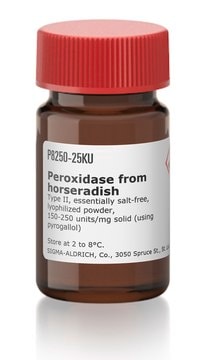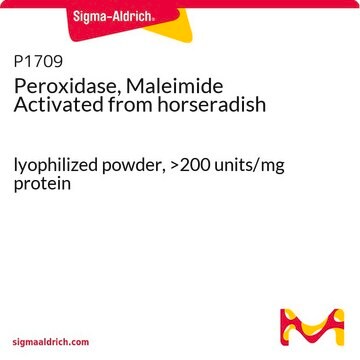10108090001
Roche
Peroxidase (POD)
grade I, from horseradish
Synonym(s):
POD, peroxidase
Sign Into View Organizational & Contract Pricing
All Photos(1)
About This Item
Recommended Products
biological source
horseradish
Quality Level
form
lyophilized (salt-free)
specific activity
≥250 units/mg protein (At 25 °C with guaiacol and H2O2 as the substrates.)
250 U/mg
packaging
pkg of 25,000 U
manufacturer/tradename
Roche
optimum pH
6.0-6.5
shipped in
wet ice
storage temp.
2-8°C
Related Categories
General description
Donor:hydrogen-peroxide oxidoreductase
Peroxidase (POD) (E.C. 1.11.1.7) is extensively expressed in most fruits and vegetables.
Application
Oxidation of electron donors (e.g., epoxidation of double bonds). Peroxidase can be coupled to other proteins via its amino groups, as well as its carbohydrate moiety. The reconstituted solution can be used directly for conjugation without prior dialysis.It has been used in ligand blotting.
Peroxidase (POD) has been used in AUR (Amplex UltraRed assay) to measure extracellular H2O2 produced from disaggregated slug cells.
Biochem/physiol Actions
Peroxidase (POD) is involved in the dehydrogenation of a large number of organic compounds including, phenols and aromatic amines, hydroquinones and hydroquinoid amines, mainly benzidine derivatives.
Quality
Contaminants: <0.001% ATPase and acid phosphatase each, <0.7% catalase
Purity number: approximately 3.0 (A403/A275)
Purity number: approximately 3.0 (A403/A275)
Preparation Note
Activator: Ammonia, pyridine, imidazole, all at pH >7; detergents.
Working solution: PBS (phosphate buffered saline) or water (starting concentration 20 mg/ml).
Working solution: PBS (phosphate buffered saline) or water (starting concentration 20 mg/ml).
Reconstitution
Solution (10 mg/ml in water): clear, red brown; pH-value: 6.0 to 7.0.
Other Notes
For life science research only. Not for use in diagnostic procedures.
signalword
Danger
hcodes
Hazard Classifications
Resp. Sens. 1 - Skin Sens. 1
Storage Class
11 - Combustible Solids
wgk_germany
WGK 1
flash_point_f
Not applicable
flash_point_c
Not applicable
Certificates of Analysis (COA)
Search for Certificates of Analysis (COA) by entering the products Lot/Batch Number. Lot and Batch Numbers can be found on a product’s label following the words ‘Lot’ or ‘Batch’.
Already Own This Product?
Find documentation for the products that you have recently purchased in the Document Library.
Customers Also Viewed
Social amoebae trap and kill bacteria by casting DNA nets
Zhang X, et al.
Nature Communications, 7, 10938-10938 (2016)
Methods of Enzymatic Analysis (1974)
Mi Kyong Lee et al.
Applied and environmental microbiology, 69(8), 4648-4657 (2003-08-07)
The Vip3A protein, secreted by Bacillus spp. during the vegetative stage of growth, represents a new family of insecticidal proteins. In our investigation of the mode of action of Vip3A, the 88-kDa Vip3A full-length toxin (Vip3A-F) was proteolytically activated to
Inactivation and conformational change of horseradish peroxidase induced by pulsed electric field
Zhong K, et al.
Food Chemistry, 92(3), 473-479 (2005)
Xuezhi Zhang et al.
Nature communications, 7, 10938-10938 (2016-03-02)
Extracellular traps (ETs) from neutrophils are reticulated nets of DNA decorated with anti-microbial granules, and are capable of trapping and killing extracellular pathogens. Various phagocytes of mammals and invertebrates produce ETs, however, the evolutionary history of this DNA-based host defence
Our team of scientists has experience in all areas of research including Life Science, Material Science, Chemical Synthesis, Chromatography, Analytical and many others.
Contact Technical Service












